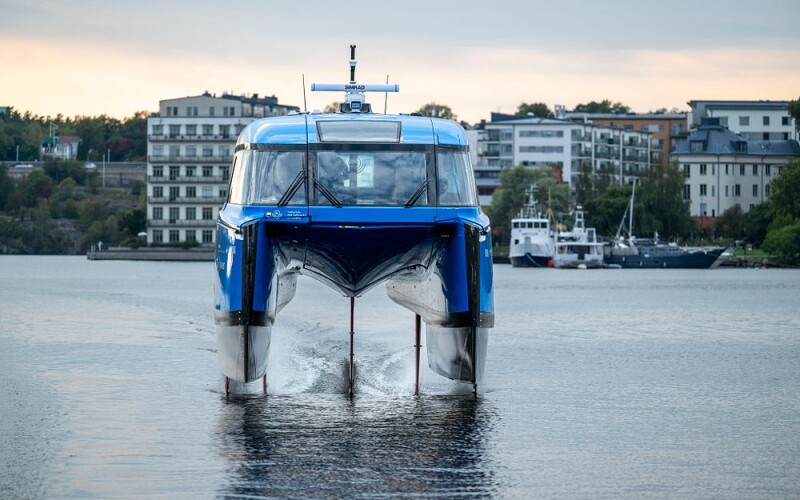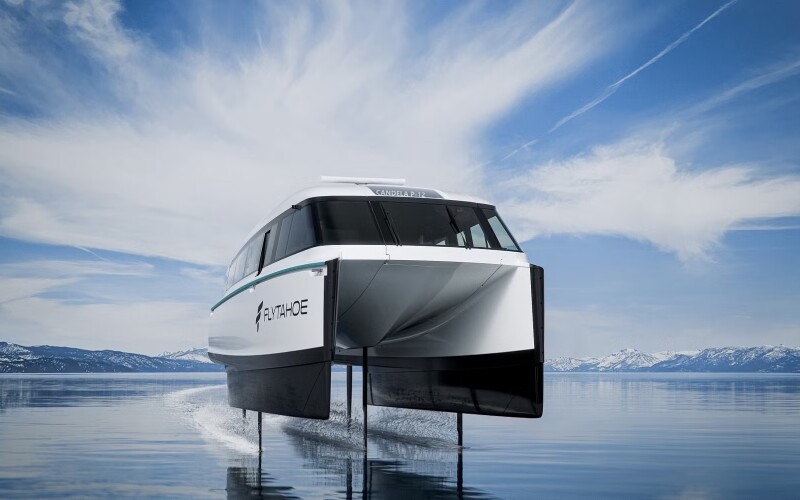Swedish tech company Candela and FlyTahoe announced plans to bring the first U.S. example of Candela’s P-12 electric hydrofoil ferry to Lake Tahoe on the California-Nevada border, where the high-speed vessel will carry passengers on a 30-minute cross-lake route.
Two examples of the 39.2’x14.7’, 30-passenger P-12 are already in service on waterways around Stockholm, Sweden. The Lake Tahoe partners bill the vessel as “the fastest electric vessel in the world with the longest range and significantly lower operational costs than diesel-powered vessels.”
“This marks the introduction of electric hydrofoiling passenger ships in the U.S., a crucial step towards decarbonizing maritime transport on American waterways,” the company statement continues.
With its lake and winter ski resorts, the Tahoe region attracts 15 million visitors year-round, and traffic congestion is a growing problem. Candela and FlyTahoe say their all-electric vessel will provide a 30-minute cross-lake service carrying up to 30 passengers, “cutting the travel time in half compared to the daily 20,000 car trips along the same route.”
The P-12 passenger cabin is designed to accommodate visitors’ skis and bikes, while ‘flying’ passengers with hydrofoil technology, which lofts the vessel on computer-controlled underwater wings above the water’s surface at high speeds.
Hydrofoil operation reduces drag and cuts energy consumption by 80% compared to conventional planing hulls, according to Candela. The computer flight controller “uses sensors and software to balance the craft above the waves and amidst the winds, adjusting the foil’s angle of attack 100 times per second to provide a silent and smooth ride,” according to the company.
"It basically works like a jet fighter, which is constantly balanced using ailerons. The principle of the P-12 is the same, except our wings fly in water instead of air," said Gustav Hasselskog, CEO and founder of Candela.
With a cruising speed of 25 knots, the FlyTahoe ferry will connect the northern and southern parts of the lake in under 30 minutes, while driving around the lake often takes over two hours in the winter. Lake Tahoe never freezes in winter, so the ferry will be an alternative for visitors to the lake’s 14 surrounding ski resorts.
“It's ironic that while millions, myself included, drive around Lake Tahoe to admire its beauty, the road sediment we generate contributes to the largest threat to the lake's famous cobalt blue clarity. Our service will provide a faster transport than cars or buses, while keeping Tahoe blue," said Ryan Meinzer, founder and CEO of FlyTahoe.
Previously a study by the Tahoe Transportation District recognized ferries as the best solution to reduce traffic congestion along Lake Tahoe’s north-south route, citing lower costs per user and faster travel times than cars and buses.
“However, that analysis, conducted before the advent of the P-12 technology, did not account for the electric ferry's ability to reduce energy usage by 80% compared to traditional ferries,” according to the partners.
Meinzer said that significantly bolsters the operational economics and overall business case for the electric hydrofoil.

Candela P-12 Specifications
Length: 11.99 meters/39.24 feet
Beam: 4.5 meters/14.76 feet
Capacity: 30 passengers (seated) + 1 crew
Propulsion: 2 x Candela C-POD, 320 kW peak power in total
Charging: Up to 200 kW DC
Service Speed: 25 knots
Range: 40 nautical miles at 25 knots service speed




